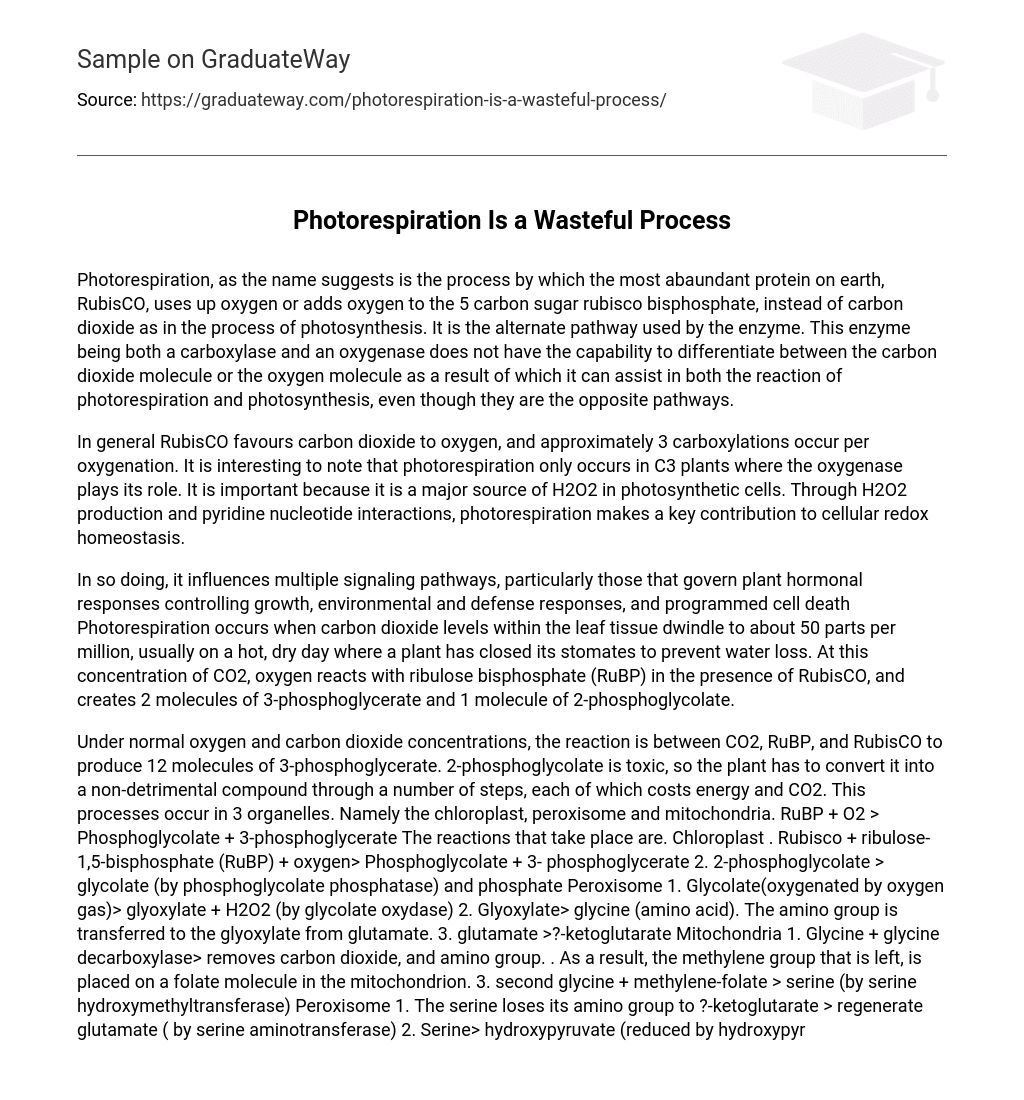Photorespiration is the opposite pathway to photosynthesis, where the protein RubisCO, which is highly abundant on earth, adds or consumes oxygen from the 5 carbon sugar rubisco bisphosphate instead of utilizing carbon dioxide. This enzyme acts as both a carboxylase and an oxygenase and cannot differentiate between carbon dioxide and oxygen molecules.
RubisCO has a preference for carbon dioxide over oxygen, resulting in approximately 3 carboxylations occurring for every oxygenation reaction. It is important to mention that photorespiration occurs specifically in C3 plants and relies on the participation of the oxygenase enzyme. As a consequence, cells involved in photosynthesis generate hydrogen peroxide (H2O2) as a significant product due to photorespiration. Furthermore, photorespiration plays a crucial role in maintaining cellular redox homeostasis by producing H2O2 and its interaction with pyridine nucleotides.
When carbon dioxide levels in the leaf tissue drop to approximately 50 parts per million, influence occurs. This typically happens on hot, dry days when a plant closes its stomates to save water. During this state, oxygen combines with ribulose bisphosphate (RuBP) in the presence of RubisCO, resulting in the creation of 2 molecules of 3-phosphoglycerate and 1 molecule of 2-phosphoglycolate. This process has an impact on various signaling pathways, specifically those involved in regulating plant hormonal responses that control growth, environmental and defense responses, and programmed cell death.
Under normal oxygen and carbon dioxide concentrations, the reaction is between CO2, RuBP, and RubisCO to produce 12 molecules of 3-phosphoglycerate. 2-phosphoglycolate is toxic, so the plant has to convert it into a non-detrimental compound through a number of steps, each of which costs energy and CO2. This processes occur in 3 organelles. Namely the chloroplast, peroxisome and mitochondria. RuBP + O2 > Phosphoglycolate + 3-phosphoglycerate The reactions that take place are.
Chloroplast: Rubisco + ribulose-1,5-bisphosphate (RuBP) + oxygen> Phosphoglycolate + 3- phosphoglycerate
Peroxisome:
- Glycolate(oxygenated by oxygen gas)> glyoxylate + H2O2 (by glycolate oxydase)
- Glyoxylate> glycine (amino acid). The amino group is transferred to the glyoxylate from glutamate.
- glutamate >?-ketoglutarate
Mitochondria:
- Glycine + glycine decarboxylase> removes carbon dioxide, and amino group. As a result, the methylene group that is left, is placed on a folate molecule in the mitochondrion.
- second glycine + methylene-folate > serine (by serine hydroxymethyltransferase)
Peroxisome:
- The serine loses its amino group to ?-ketoglutarate > regenerate glutamate ( by serine aminotransferase)
- Serine> hydroxypyruvate (reduced by hydroxypyruvate reductase)> glycerate
Chloroplast:
- Glycerate (by glycerate kinase) > 3-phosphoglycerate
Photorespiration is an inefficient process that does not generate 3-phosphoglyceraldehyde (PGAL), a vital component used by plants for numerous functions. Additionally, photorespiration does not produce ATP and results in a net loss of carbon and nitrogen, essential requirements for plant growth. Consequently, the growth of plants is hindered. Furthermore, photorespiration diminishes the efficiency of photosynthesis by removing carbon molecules from the Calvin Cycle. This reduction process relies on NADH and ATP, which are primarily produced during the light reaction, resulting in wasteful utilization for the plant. The carbon dioxide that would normally be used for sugar generation is diverted from the Calvin cycle. Moreover, since two glycines are required to complete the photorespiration pathway, two glycolates must be obtained from the Calvin cycle. Out of these four carbons extracted, one is lost as carbon dioxide while the remaining three are recycled back into the Calvin cycle, resulting in a 25% carbon loss. As a whole, photorespiration reduces the overall productivity of the plant.
Reference
The following sources are listed: Class lecture, http://plantphys.info/plant_physiology/photoresp.shtml, http://www.answerbag.com/, http://en.wikipedia.org/wiki/Photorespiration, and http://www2.mcdaniel.edu.





